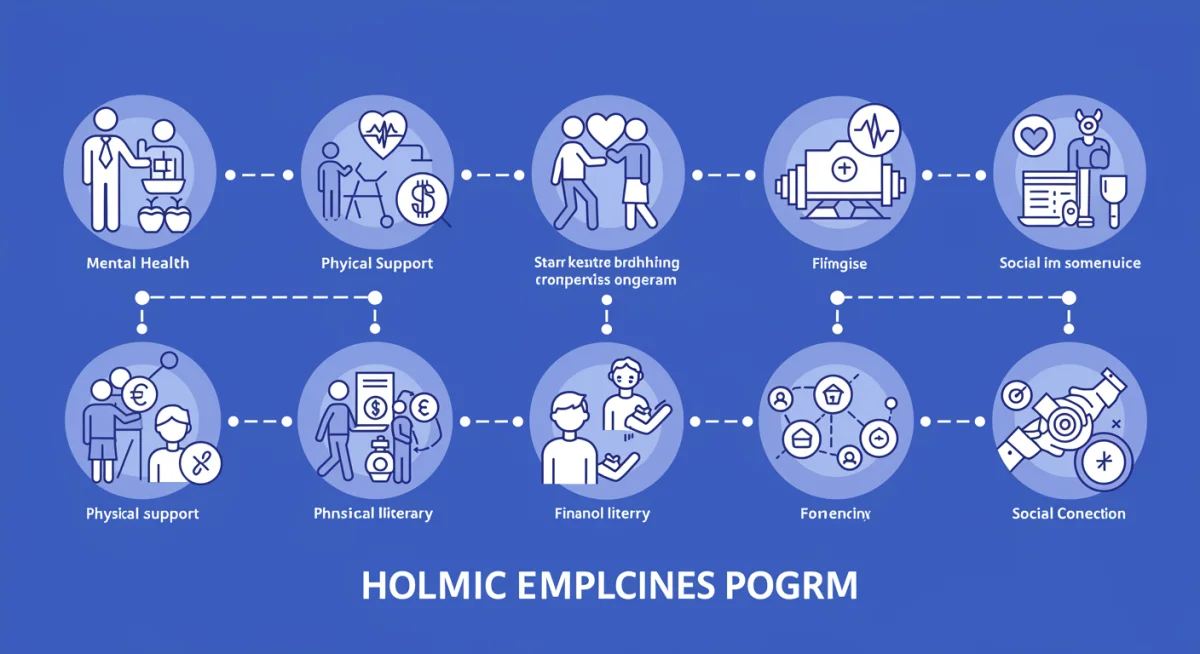Employee Wellness Programs: Boost Well-being 15% with New Offerings

Modern employee wellness programs are shifting towards holistic well-being, integrating mental health, financial literacy, and social connection to achieve a measurable boost in personal well-being and overall employee satisfaction.
In today’s fast-paced corporate landscape, the concept of employee well-being has evolved far beyond basic health insurance. The latest in employee wellness programs are not just perks; they are strategic investments aimed at fostering a healthier, happier, and more productive workforce. Understanding and leveraging these new offerings can lead to a significant boost, potentially 15% or more, in personal well-being, directly impacting both individual lives and organizational success.
The Evolution of Employee Wellness: Beyond the Gym Membership
Employee wellness initiatives have undergone a significant transformation. What once primarily focused on physical health, often limited to discounted gym memberships or basic health screenings, has expanded into a comprehensive, multi-dimensional approach. This evolution reflects a deeper understanding of human needs and the complex factors that contribute to overall well-being.
Today’s cutting-edge programs recognize that an individual’s well-being is a tapestry woven from various threads: physical, mental, emotional, financial, and social. Companies are now designing offerings that address these diverse aspects, creating a more robust and effective support system for their employees.
Shifting Focus to Holistic Health
The modern emphasis is on a holistic view of employee health. This means acknowledging that stress from financial worries can impact physical health, just as mental health challenges can affect productivity and engagement. Forward-thinking organizations are integrating solutions that cater to these interconnected elements.
- Mental Health Support: Access to therapy, mindfulness apps, and stress management workshops.
- Financial Wellness: Education on budgeting, retirement planning, and debt management.
- Social Connection: Team-building activities, mentorship programs, and community involvement opportunities.
- Physical Activity: On-site fitness classes, ergonomic assessments, and incentives for active living.
By adopting this holistic perspective, businesses are not just reacting to problems but proactively building environments where employees can thrive across all facets of their lives. This comprehensive approach is crucial for achieving the desired boost in personal well-being.
Integrating Mental Health and Emotional Support
Perhaps one of the most critical shifts in employee wellness programs is the increased focus on mental health and emotional support. Acknowledging the pervasive impact of stress, anxiety, and burnout, employers are now prioritizing initiatives that provide accessible and destigmatized mental health resources.
This commitment goes beyond merely offering an Employee Assistance Program (EAP). It involves cultivating a culture of openness, understanding, and proactive care, recognizing that a mentally healthy workforce is a resilient and innovative one.
Key Components of Modern Mental Health Programs
Effective mental health programs are multifaceted, offering a range of options to suit diverse needs. They are designed to be easily accessible and confidential, encouraging employees to seek help without fear of judgment.
- Telehealth and Virtual Therapy: Convenient access to licensed therapists and counselors from anywhere.
- Mindfulness and Meditation Resources: Subscriptions to apps like Calm or Headspace, and guided meditation sessions.
- Stress Management Workshops: Practical strategies for coping with workplace demands and personal stressors.
- Manager Training: Equipping leaders to recognize signs of distress and support their teams effectively.
The integration of robust mental health and emotional support demonstrates a genuine investment in employees’ overall well-being, fostering a more compassionate and productive work environment. This focus is indispensable for any organization aiming to boost personal well-being significantly.
Financial Wellness Initiatives: Securing Employees’ Futures
Financial stress is a leading cause of anxiety and distraction for many employees, directly impacting their focus and performance at work. Recognizing this, forward-thinking organizations are incorporating comprehensive financial wellness programs into their overall employee benefits package. These initiatives aim to empower employees with the knowledge and tools to manage their finances effectively, reducing stress and fostering a sense of security.
These programs go beyond simple retirement plans, delving into practical, everyday financial management that can make a tangible difference in employees’ lives. By addressing financial well-being, companies contribute to a more stable and less stressed workforce.

Financial education and counseling are often at the core of these offerings. This includes workshops, one-on-one coaching, and access to digital tools that help employees navigate complex financial decisions, from budgeting to investing.
Practical Financial Support Offerings
The scope of financial wellness programs is expanding to include a variety of resources designed to meet employees at different stages of their financial journey.
- Debt Management Assistance: Resources and counseling to help employees reduce and manage debt.
- Retirement Planning Education: Guidance on 401(k) contributions, investment strategies, and long-term financial security.
- Emergency Savings Programs: Tools and incentives to help employees build a financial safety net.
- Student Loan Repayment Support: Employer contributions or advisory services for student loan management.
By alleviating financial burdens, these programs enable employees to focus more effectively on their work and personal lives, contributing significantly to a boost in their overall personal well-being. This proactive approach to financial health is a hallmark of truly supportive employee wellness programs.
The Role of Technology in Modern Wellness Programs
Technology has become an indispensable tool in the delivery and personalization of modern employee wellness programs. From wearable devices tracking physical activity to AI-powered platforms offering personalized mental health support, technological innovations are making wellness more accessible, engaging, and tailored to individual needs. This integration allows for a broader reach and more effective monitoring of program impact.
Digital platforms and apps provide employees with flexibility and convenience, enabling them to engage with wellness resources at their own pace and from any location. This is particularly crucial in hybrid or remote work environments, where traditional on-site programs may not be feasible.
Leveraging Digital Tools for Enhanced Engagement
The strategic use of technology can significantly boost engagement in wellness initiatives, transforming passive offerings into interactive experiences.
- Wellness Apps and Platforms: Centralized hubs for all wellness resources, from fitness challenges to mindfulness exercises.
- Wearable Device Integration: Syncing fitness trackers to wellness platforms for personalized activity goals and rewards.
- AI-Powered Coaching: Virtual coaches providing personalized recommendations for exercise, nutrition, and mental well-being.
- Gamification: Incorporating game-like elements, such as points, badges, and leaderboards, to motivate participation.
Technology not only streamlines the administration of wellness programs but also enhances the user experience, making it easier for employees to adopt healthy habits and actively participate in their well-being journey. This technological backbone is key to maximizing the impact of employee wellness programs.
Personalized Wellness: Tailoring Programs to Individual Needs
One size no longer fits all when it comes to employee wellness. Modern programs are increasingly moving towards personalization, recognizing that each employee has unique needs, preferences, and health goals. This tailored approach significantly increases engagement and the effectiveness of wellness initiatives, leading to a more substantial boost in personal well-being.
Personalization involves offering a diverse menu of options and allowing employees to choose what resonates most with them. It also means using data and feedback to adapt programs over time, ensuring they remain relevant and impactful.
Strategies for Effective Personalization
Creating personalized wellness experiences requires a deep understanding of the workforce and a commitment to flexibility.
- Health Risk Assessments (HRAs): Confidential assessments to identify individual health risks and recommend targeted interventions.
- Interest Surveys: Gathering employee feedback on preferred wellness activities and topics.
- Flexible Benefit Structures: Offering a range of wellness credits or stipends that employees can allocate to services of their choice.
- Individual Coaching: Providing access to personal health coaches, financial advisors, or mental health professionals.
By empowering employees to take ownership of their wellness journey through personalized choices, organizations can foster a sense of autonomy and engagement. This bespoke approach ensures that resources are utilized effectively, maximizing the positive impact of employee wellness programs on individual well-being.
Measuring Impact and Proving ROI of Wellness Programs
For employee wellness programs to gain sustained investment and executive buy-in, it’s crucial to demonstrate their tangible impact and return on investment (ROI). Beyond anecdotal evidence, modern wellness initiatives employ sophisticated metrics and data analysis to quantify their effectiveness, showing how they contribute to both individual well-being and organizational success.
Measuring ROI involves looking at various indicators, from healthcare cost reductions to improvements in productivity and employee retention. This data-driven approach allows organizations to refine their programs and showcase the strategic value of investing in employee well-being.
Key Metrics for Evaluating Wellness Programs
A comprehensive evaluation strategy involves tracking a combination of health, engagement, and financial metrics.
- Healthcare Cost Savings: Reductions in insurance claims, emergency room visits, and prescription drug costs.
- Absenteeism and Presenteeism Rates: Decreased sick days and improved on-the-job productivity.
- Employee Engagement and Satisfaction: Higher participation rates in wellness activities and positive feedback.
- Retention Rates: Lower employee turnover, indicating a more satisfied and committed workforce.
- Productivity Improvements: Enhanced focus, reduced errors, and increased output due to better health.
By rigorously measuring these outcomes, companies can prove that investing in employee wellness programs is not just a cost, but a strategic asset that yields significant returns. This evidence-based approach reinforces the value of these initiatives, securing their place as a cornerstone of modern HR strategy and unequivocally demonstrating their capacity to boost personal well-being and organizational health.
| Key Aspect | Brief Description |
|---|---|
| Holistic Focus | Modern programs address physical, mental, financial, and social well-being. |
| Mental Health Integration | Prioritizing accessible mental health resources and support systems. |
| Personalization & Tech | Tailoring offerings to individual needs using advanced digital tools. |
| Measuring ROI | Quantifying program effectiveness through data on health, engagement, and financial metrics. |
Frequently Asked Questions About Employee Wellness Programs
Modern employee wellness programs typically encompass physical health activities, mental health support, financial literacy workshops, and opportunities for social connection. They move beyond basic benefits to offer a comprehensive, holistic approach to well-being, recognizing the interconnectedness of these aspects for overall employee health.
Technology plays a crucial role by providing accessible platforms for resources, personalized tracking through wearables, AI-driven coaching, and gamification to boost engagement. It allows for flexible participation, making wellness programs more convenient and tailored to individual employee schedules and preferences, especially in diverse work settings.
Financial stress is a significant contributor to employee anxiety and decreased productivity. By offering financial wellness programs, employers help alleviate these concerns through education on budgeting, debt management, and retirement planning. This support fosters greater financial security, leading to reduced stress and improved focus at work.
Companies measure ROI through various metrics, including reductions in healthcare costs, lower absenteeism and presenteeism rates, increased employee engagement and satisfaction, and improved retention. These data points collectively demonstrate the positive financial and cultural impact of investing in employee well-being initiatives.
Personalized wellness means tailoring programs to meet the unique needs and preferences of individual employees. This involves offering a diverse range of options, using health risk assessments, and incorporating employee feedback to create bespoke wellness paths. It ensures resources are relevant and maximally effective for each person.
Conclusion
The landscape of employee wellness programs is continuously evolving, moving towards more holistic, technologically integrated, and personalized approaches. By strategically leveraging these new offerings, organizations can achieve a tangible boost in personal well-being for their employees, fostering a healthier, more engaged, and ultimately more productive workforce. Investing in comprehensive wellness is no longer just a trend; it’s a fundamental pillar of sustainable business success and a testament to an organization’s commitment to its most valuable asset: its people. Embracing these advanced strategies will undoubtedly yield significant returns, both human and financial.





